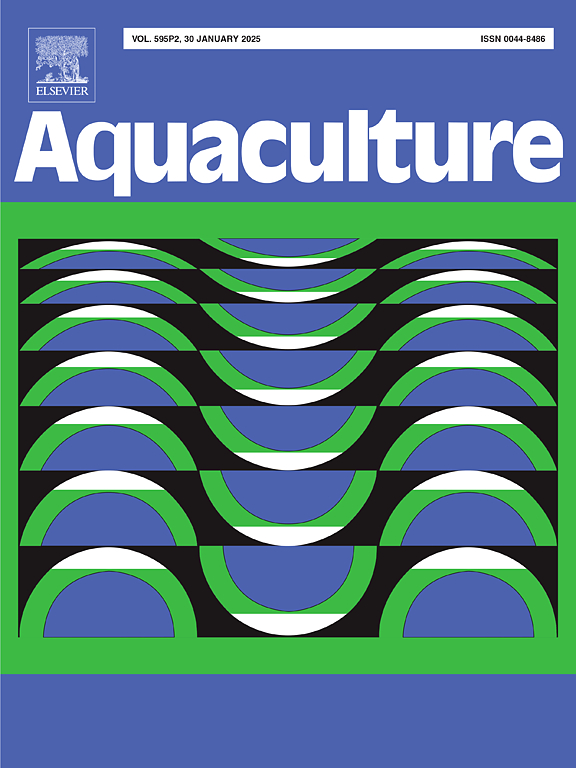Histological and transcriptome analysis of gonadal development provides new insights into the characteristics of sex differentiation and the screening of key genes in the golden pompano (Trachinotus blochii)
IF 3.9
1区 农林科学
Q1 FISHERIES
引用次数: 0
Abstract
Trachinotus blochii is one of the important mariculture fish species in China and is a key driver of offshore aquaculture development. The growth of golden pompano is sexually dimorphic, with females growing faster than males, suggesting that monosex farming could significantly improve economic efficiency. Therefore, it is crucial to study the early gonadal development, differentiation characteristics, and the regulatory genes involved to understanding the molecular mechanisms of sex determination and differentiation in T. blochii. In this study, juvenile T. blochii were sampled continuously from 0 to 186 days post-hatching (dph). Determine its genetic sex through sex molecular markers, and histological sections were used to observe the gonadal development of males and females at different ages. Transcriptomic analysis of the gonads at different stages of sex differentiation was also conducted to screen for sex-determining genes. The results showed that a single primordial germ cell (PGC) first appeared on one side of the primordial gonad at 8 dph. At 12 dph, a small number of somatic cells surrounded the PGCs, indicating the gonadal primordium had formed. By 15 dph, a single layer of somatic cells completely enveloped the PGCs, forming the primordial gonad. At 41 dph, a narrow slit-like ovarian cavity was observed in the gonadal section, marking the beginning of ovarian development. At 78 dph, a distinct testicular primordium was observed, signaling the onset of testicular development. By 105 dph, a small number of oocytes were present, indicating cytological ovarian differentiation. By 186 dph, a large number of primary spermatocytes and a small number of secondary spermatocytes were present, marking cytological testicular differentiation. In summary, based on histology, ovarian differentiation in T. blochii occurred at 41 dph, while testicular differentiation occurred at 78 dph. Transcriptomics revealed a total of 22,278 genes across 36 cDNA libraries, with 125, 119, 191, 130, 119, and 1745 differentially expressed genes (DEGs) at the six respective developmental stages (10, 20, 30, 45, 60, and 90 dph). Enrichment analysis identified several GO terms significantly associated with sex, including follicle development, regulation of oogenesis, reproductive development, sperm motility, and oocyte maturation. KEGG enrichment revealed key pathways related to gonadal development and sex differentiation, such as estrogen signaling, ovarian steroidogenesis, steroid hormone biosynthesis, progesterone-mediated oocyte maturation, and oocyte meiosis. From the DEGs related to sex, 100 genes were screened through GO and KEGG enrichment analyses. Protein-protein interaction network analysis indicated that genes such as cyp19a1, hsd17β7, hsd17β1, hsd17β3, hsd3β, ugt1a1, hsd17β12b, cyp7a1, esr2, and bmp15 play important roles in sex differentiation in T. blochii. This study systematically analyzed the gonadal development and differentiation patterns in T. blochii and identified key genes regulating sex differentiation, providing fundamental data for further research on the sex control mechanisms and monosex breeding of this species.
求助全文
约1分钟内获得全文
求助全文
来源期刊

Aquaculture
农林科学-海洋与淡水生物学
CiteScore
8.60
自引率
17.80%
发文量
1246
审稿时长
56 days
期刊介绍:
Aquaculture is an international journal for the exploration, improvement and management of all freshwater and marine food resources. It publishes novel and innovative research of world-wide interest on farming of aquatic organisms, which includes finfish, mollusks, crustaceans and aquatic plants for human consumption. Research on ornamentals is not a focus of the Journal. Aquaculture only publishes papers with a clear relevance to improving aquaculture practices or a potential application.
 求助内容:
求助内容: 应助结果提醒方式:
应助结果提醒方式:


